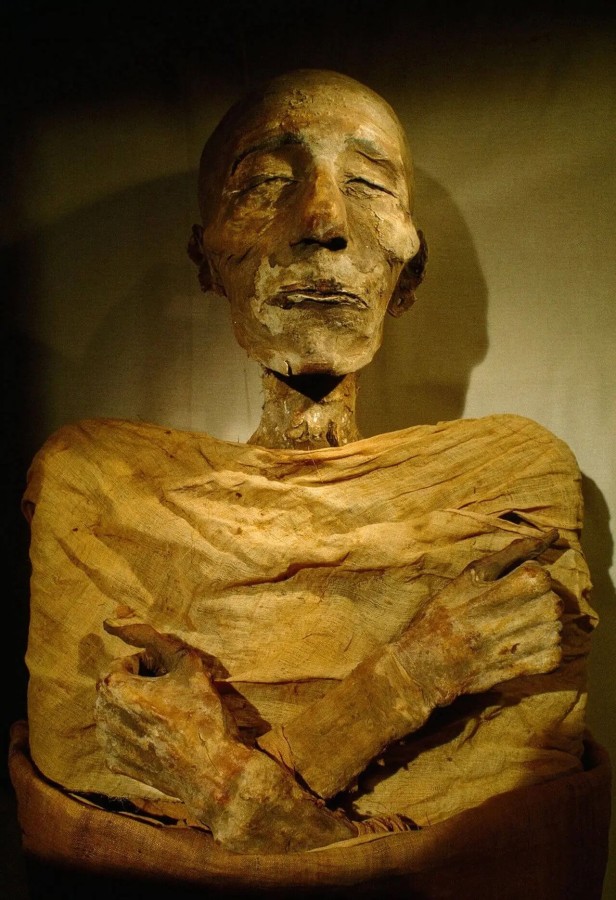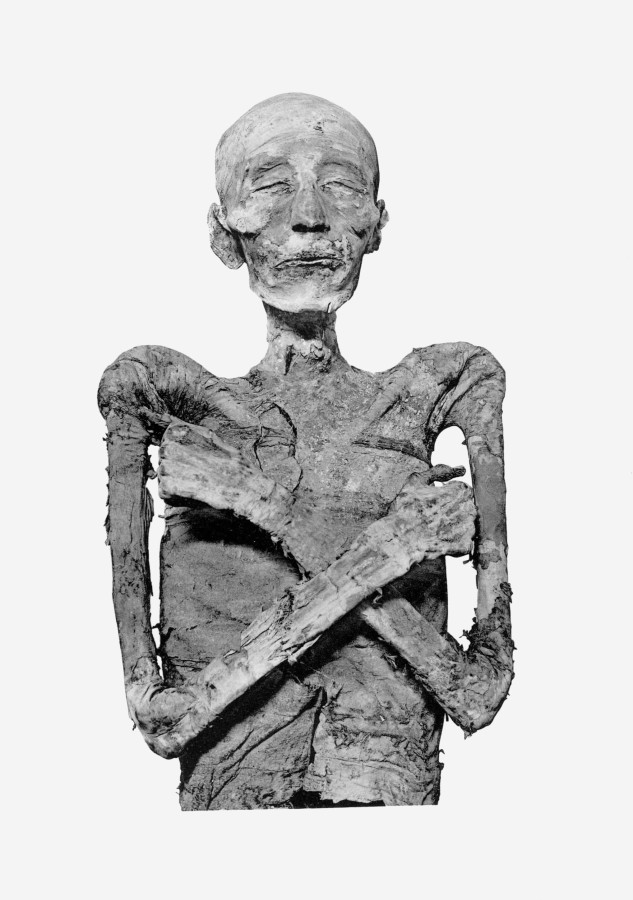Mummy of Merneptah – Egypt Museum
King Merneptah was originally buried within tomb (KV8) in the Valley of the Kings, but his mummy was not found there. In 1898 it was located along with eighteen other mummies in the mummy cache found in the tomb of Amenhotep II (KV35) by Victor Loret.

In their search for gold, the tomb-robbers split the mummy’s right clavicle and injured the left shoulder, possibly by using a knife or an axe to cut a hole through the body. The skin of the mummy became unusually brighter, mainly due to the salt that was heavily used in the mummification process. The king apparently suffered from dental problems and fractures in his thighbones.

Mummy of Merneptah
In 1980, James Harris and Edward F. Wente conducted a series of X-ray examinations on New Kingdom Kings crania and skeletal remains, which included the mummified remains of Merneptah.
Related: Mummy of Ramesses II
The analysis in general found strong similarities between the New Kingdom rulers of the 19th Dynasty and 20th Dynasty with Mesolithic Nubian samples.
The authors also noted affinities with modern Mediterranean populations of Levantine origin. Harris and Wente suggested this represented admixture as the Rammessides were of northern origin.
Merneptah had several notable achievements during his reign.
Military Campaigns
Merneptah is best known for his military campaigns, particularly his victory over the Libyans and the Sea Peoples. He successfully defended Egypt against these external threats and is famous for his inscription, known as the Merneptah Stele, which documents his triumphs.
Building Projects
Merneptah continued the construction and restoration of various temples and monuments throughout Egypt. He made contributions to the Karnak Temple complex in Thebes and initiated the construction of the Mortuary Temple of Merneptah.
Diplomacy
Merneptah engaged in diplomatic relations with neighboring kingdoms and city-states. He maintained alliances and negotiated treaties to ensure stability and security for Egypt.
Cultural and Religious Patronage
Merneptah supported the arts, literature, and religious practices of ancient Egypt. He commissioned statues, reliefs, and other artistic works, and he continued the religious traditions and rituals of his predecessors.

Mummy of Merneptah
Succession
Merneptah successfully secured the throne and established a stable succession by designating his son, Seti II, as his successor. This ensured a smooth transition of power after his death.
These achievements contributed to the overall stability and prosperity of Egypt during Merneptah’s reign.
New Kingdom, 19th Dynasty, reign of Merneptah, ca. 1213-1203 BC. Now in the National Museum of Egyptian Civilization (NMEC), Cairo. JE 34562
Related Post
A shocking documentary proves that mermaids do exist
SHOCKING Revelation: Thuya, Mother of Queen Tiye, Was the Grandmother of Akhenaten and Tutankhamun—What Ancient Egyptian Secrets Did She Leave Behind?
Breaking News: Astonishing Discoveries at Karahan Tepe Confirm an Extraterrestrial Civilization is Hiding on Earth, and NO ONE Knows!
Breaking News: Researchers FINALLY Discover U.S. Navy Flight 19 After 75 Years Lost in the Bermuda Triangle!
NASA’s Secret Investigation: Uncovering the Astonishing Mystery of the UFO Crash on the Mountain!
Explosive UFO Docs LEAKED: Startling Proof That Aliens Ruled Ancient Egypt!